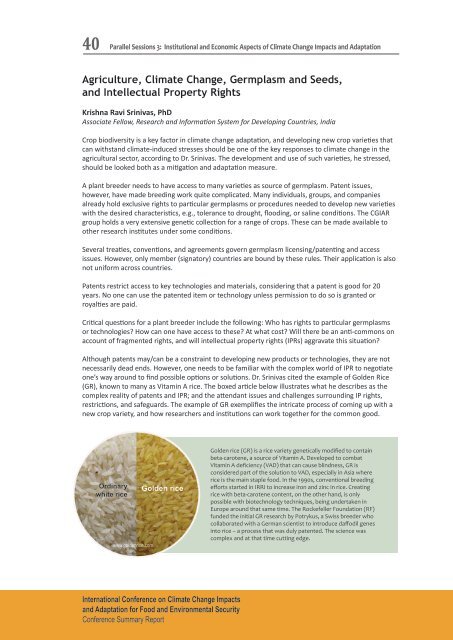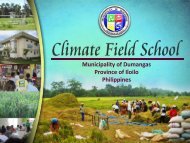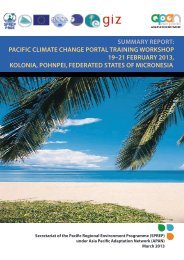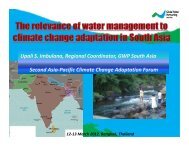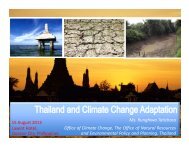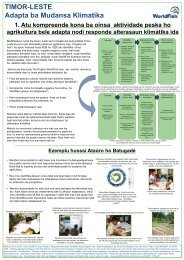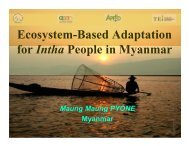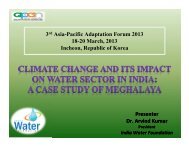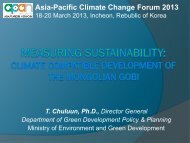PDF file (2.44 MB) - Asia Pacific Adaptation Network
PDF file (2.44 MB) - Asia Pacific Adaptation Network
PDF file (2.44 MB) - Asia Pacific Adaptation Network
Create successful ePaper yourself
Turn your PDF publications into a flip-book with our unique Google optimized e-Paper software.
40Parallel Sessions 3: Institutional and Economic Aspects of Climate Change Impacts and <strong>Adaptation</strong>Agriculture, Climate Change, Germplasm and Seeds,and Intellectual Property RightsKrishna Ravi Srinivas, PhDAssociate Fellow, Research and Information System for Developing Countries, IndiaCrop biodiversity is a key factor in climate change adaptation, and developing new crop varieties thatcan withstand climate-induced stresses should be one of the key responses to climate change in theagricultural sector, according to Dr. Srinivas. The development and use of such varieties, he stressed,should be looked both as a mitigation and adaptation measure.A plant breeder needs to have access to many varieties as source of germplasm. Patent issues,however, have made breeding work quite complicated. Many individuals, groups, and companiesalready hold exclusive rights to particular germplasms or procedures needed to develop new varietieswith the desired characteristics, e.g., tolerance to drought, flooding, or saline conditions. The CGIARgroup holds a very extensive genetic collection for a range of crops. These can be made available toother research institutes under some conditions.Several treaties, conventions, and agreements govern germplasm licensing/patenting and accessissues. However, only member (signatory) countries are bound by these rules. Their application is alsonot uniform across countries.Patents restrict access to key technologies and materials, considering that a patent is good for 20years. No one can use the patented item or technology unless permission to do so is granted orroyalties are paid.Critical questions for a plant breeder include the following: Who has rights to particular germplasmsor technologies? How can one have access to these? At what cost? Will there be an anti-commons onaccount of fragmented rights, and will intellectual property rights (IPRs) aggravate this situation?Although patents may/can be a constraint to developing new products or technologies, they are notnecessarily dead ends. However, one needs to be familiar with the complex world of IPR to negotiateone’s way around to find possible options or solutions. Dr. Srinivas cited the example of Golden Rice(GR), known to many as Vitamin A rice. The boxed article below illustrates what he describes as thecomplex reality of patents and IPR; and the attendant issues and challenges surrounding IP rights,restrictions, and safeguards. The example of GR exemplifies the intricate process of coming up with anew crop variety, and how researchers and institutions can work together for the common good.Ordinarywhite ricewww.goldenrice.comGolden riceGolden rice (GR) is a rice variety genetically modified to containbeta-carotene, a source of Vitamin A. Developed to combatVitamin A deficiency (VAD) that can cause blindness, GR isconsidered part of the solution to VAD, especially in <strong>Asia</strong> whererice is the main staple food. In the 1990s, conventional breedingefforts started in IRRI to increase iron and zinc in rice. Creatingrice with beta-carotene content, on the other hand, is onlypossible with biotechnology techniques, being undertaken inEurope around that same time. The Rockefeller Foundation (RF)funded the initial GR research by Potrykus, a Swiss breeder whocollaborated with a German scientist to introduce daffodil genesinto rice – a process that was duly patented. The science wascomplex and at that time cutting edge.International Conference on Climate Change Impactsand <strong>Adaptation</strong> for Food and Environmental SecurityConference Summary Report


